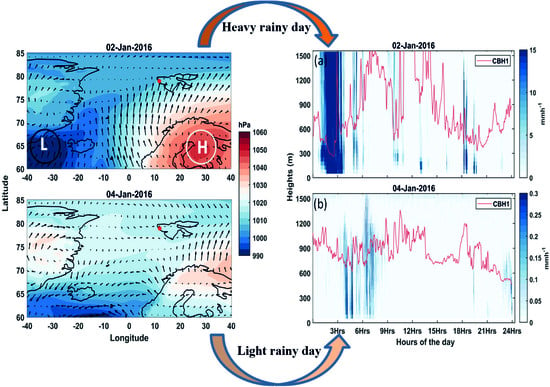Observation of Cloud Base Height and Precipitation Characteristics at a Polar Site Ny-Ålesund, Svalbard Using Ground-Based Remote Sensing and Model Reanalysis
Abstract
:1. Introduction
2. Data and Methodology
2.1. Ceilometer and Cloud Base Height
2.2. Precipitation from Micro Rain Radar (MRR2)
2.3. Radiosonde Measurements
2.4. ERA-5 Reanalysis
3. Results and Discussion
3.1. CBH Characteristics at Ny-Ålesund
3.2. Monthly Mean Cloud Heights
3.3. Monthly Cloud Characteristics
3.4. Cloud Base Heights and Precipitation Relationships
3.5. A Case Study of Two Contrasting Winter Precipitation Events
3.6. Roles of Meteorological Conditions
4. Conclusions
- The summer and autumn seasons have the most cloud occurrences (>80%), while the spring season has the least cloud occurrences (~59%) at Ny-Ålesund. Within a year, the august month attends maximum cloud occurrences (>90%) while April shows the minimum values (~55%).
- The probability of CBH2 attends its maximum value in the summer and minimum in the spring. Summer values are higher, meaning the lowest level clouds are thinner than in other seasons.
- Low-level clouds are present in 76.2% of CBH detection cases, whereas mid and high-level clouds are found in 16.2% and 7.6% of cases, respectively.
- The maximum (approximately 40%) lowest cloud base is found at a height range of 0.5–1 km in all four seasons. An increased presence of the lowest cloud bases below 0.5 km can be noted in summer (~30%) compared to in winter (<10%).
- Vertically averaged daily precipitation intensities (liquid and solid) are found to exhibit various ranges with a maximum value ~12 mmh−1. Our observations show that most of these high precipitation events are linked to low clouds (CBH1 < 2000 m).
- Distinct vertical movements (updrafts/downdrafts) in the first cloud base were observed during two different (heavy and light) wintertime precipitation events. Along with local atmospheric state variables (temperature and humidity), the intensities of precipitation and cloud movements were linked to frontal activities connected to synoptic scale meteorology.
Author Contributions
Funding
Data Availability Statement
Acknowledgments
Conflicts of Interest
References
- Holland, M.M.; Bitz, C.M. Polar amplification of climate change in coupled models. Clim. Dyn. 2003, 21, 221–232. [Google Scholar] [CrossRef]
- Serreze, M.C.; Barry, R.G. Processes and impacts of Arctic amplification: A research synthesis. Glob. Planet. Chang. 2011, 77, 85–96. [Google Scholar] [CrossRef]
- Graff, L.S.; Iversen, T.; Bethke, I.; Debernard, J.B.; Seland, Ø.; Bentsen, M.; Kirkevåg, A.; Li, C.; Olivié, D.J.L. Arctic amplification under global warming of 1.5 and 2 °C in NorESM1-Happi. Earth Syst. Dyn. 2019, 10, 569–598. [Google Scholar] [CrossRef] [Green Version]
- Cohen, J.; Zhang, X.; Francis, J.; Jung, T.; Kwok, R.; Overland, J.; Tayler, P.C.; Lee, S.; Laliberte, F.; Feldstein, S.; et al. Arctic change and possible influence on mid-latitude climate and weather: A US CLIVAR White Paper. US CLIVAR Rep. 2018, 41. [Google Scholar] [CrossRef]
- Svensson, G.; Karlsson, J. On the arctic wintertime climate in global climate models. J. Clim. 2011, 24, 5757–5771. [Google Scholar] [CrossRef]
- Curry, J.A.; Rossow, W.B.; Randall, D.; Schramm, J.L. Overview of arctic cloud and radiation characteristics. J. Clim. 1996, 9, 1731–1764. [Google Scholar] [CrossRef] [Green Version]
- Flato, G.; Marotzke, J.; Abiodun, B.; Braconnot, P.; Chou, S.C.; Collins, W.; Cox, P.; Driouech, F.; Emori, S.; Eyring, V.; et al. Evaluation of Climate Models. In Climate Change 2013: The Physical Science Basis. Contribution of Working Group I to the Fifth Assessment Report of the Intergovernmental Panel on Climate Change; Cambridge University Press: Cambridge, UK, 2013; pp. 741–866. [Google Scholar] [CrossRef] [Green Version]
- Kay, J.E.; L’Ecuyer, T.; Chepfer, H.; Loeb, N.; Morrison, A.; Cesana, G. Recent Advances in Arctic Cloud and Climate Research. Curr. Clim. Chang. Rep. 2016, 2, 159–169. [Google Scholar] [CrossRef] [Green Version]
- Goosse, H.; Kay, J.E.; Armour, K.C.; Bodas-Salcedo, A.; Chepfer, H.; Docquier, D.; Jonko, A.; Kushner, P.J.; Lecomte, O.; Massonnet, F.; et al. Quantifying climate feedbacks in polar regions. Nat. Commun. 2018, 9, 1919. [Google Scholar] [CrossRef] [PubMed]
- Dai, A.; Luo, D.; Song, M.; Liu, J. Arctic amplification is caused by sea-ice loss under increasing CO2. Nat. Commun. 2019, 10, 121. [Google Scholar] [CrossRef] [Green Version]
- Screen, J.A.; Simmonds, I. The central role of diminishing sea ice in recent Arctic temperature amplification. Nature 2010, 464. [Google Scholar] [CrossRef] [PubMed] [Green Version]
- Lambert, F.; Kug, J.-S.; Park, R.J.; Mahowald, N.; Winckler, G.; Abe-Ouchi, A.; O’ishi, R.; Takemura, T.; Lee, J.-H. The role of mineral-dust aerosols in polar temperature amplification. Nat. Clim. Chang. 2013, 3. [Google Scholar] [CrossRef]
- Alexeev, V.A.; Jackson, C.H. Polar amplification: Is atmospheric heat transport important? Clim. Dyn. 2013, 41, 533–547. [Google Scholar] [CrossRef]
- Cai, M. Dynamical amplification of polar warming. Geophys. Res. Lett. 2005, 32, L22710. [Google Scholar] [CrossRef]
- Huang, Y.; Dong, X.; Bailey, D.A.; Holland, M.M.; Xi, B.; DuVivier, A.K.; Kay, J.E.; Landrum, L.L.; Deng, Y. Thicker Clouds and Accelerated Arctic Sea Ice Decline: The Atmosphere-Sea Ice Interactions in Spring. Geophys. Res. Lett. 2019, 46, 6980–6989. [Google Scholar] [CrossRef] [Green Version]
- Bennartz, R.; Shupe, M.D.; Turner, D.D.; Walden, V.P.; Steffen, K.; Cox, C.J.; Kulie, M.S.; Miller, N.B.; Pettersen, C. July 2012 Greenland melt extent enhanced by low-level liquid clouds. Nature 2013, 496, 83–86. [Google Scholar] [CrossRef]
- Cox, C.J.; Uttal, T.; Long, C.N.; Stone, R.S.; Shupe, M.D.; Starkweather, S. The role of springtime arctic clouds in determining autumn sea ice extent. J. Clim. 2016, 29, 6581–6596. [Google Scholar] [CrossRef]
- Liu, Y.; Key, J.R. Assessment of arctic cloud cover anomalies in atmospheric reanalysis products using satellite data. J. Clim. 2016, 29, 6065–6083. [Google Scholar] [CrossRef]
- Ramanathan, V.; Cess, R.D.; Harrison, E.F.; Minnis, P.; Barkstrom, B.R.; Ahmad, E.; Hartmann, D. Cloud-radiative forcing and climate: Results from the earth radiation budget experiment. Science 1989, 243, 57–63. [Google Scholar] [CrossRef] [Green Version]
- Vavrus, S.; Holland, M.M.; Bailey, D.A. Changes in Arctic clouds during intervals of rapid sea ice loss. Clim. Dyn. 2011, 36, 1475–1489. [Google Scholar] [CrossRef] [Green Version]
- Cronin, T.W.; Tziperman, E. Low clouds suppress Arctic air formation and amplify high-latitude continental winter warming. Proc. Natl. Acad. Sci. USA 2015, 112, 11490–11495. [Google Scholar] [CrossRef] [Green Version]
- Gong, T.; Feldstein, S.; Lee, S. The role of downward infrared radiation in the recent arctic winter warming trend. J. Clim. 2017, 30, 4937–4949. [Google Scholar] [CrossRef]
- Vihma, T.; Screen, J.; Tjernström, M.; Newton, B.; Zhang, X.; Popova, V.; Deser, C.; Holland, M.; Prowse, T. The atmospheric role in the Arctic water cycle: A review on processes, past and future changes, and their impacts. J. Geophys. Res. G Biogeosci. 2016, 121, 586–620. [Google Scholar] [CrossRef] [Green Version]
- Intrieri, J.M.; Shupe, M.D.; Uttal, T.; McCarty, B.J. An annual cycle of Arctic cloud characteristics observed by radar and lidar at SHEBA. J. Geophys. Res. Ocean. 2002, 107. [Google Scholar] [CrossRef]
- Shupe, M.D. Clouds at arctic atmospheric observatories. Part II: Thermodynamic phase characteristics. J. Appl. Meteorol. Climatol. 2011, 50, 645–661. [Google Scholar] [CrossRef]
- Eastman, R.; Warren, S.G. Arctic Cloud Changes from Surface and Satellite Observations. J. Clim. 2010, 23, 4233–4242. [Google Scholar] [CrossRef] [Green Version]
- Maturilli, M.; Ebell, K. Twenty-five years of cloud base height measurements by ceilometer in Ny-Ålesund, Svalbard. Earth Syst. Sci. Data 2018, 10, 1451–1456. [Google Scholar] [CrossRef] [Green Version]
- Mioche, G.; Jourdan, O.; Ceccaldi, M.; Delanoë, J. Variability of mixed-phase clouds in the Arctic with a focus on the Svalbard region: A study based on spaceborne active remote sensing. Atmos. Chem. Phys. 2015, 15, 2445–2461. [Google Scholar] [CrossRef] [Green Version]
- Chernokulsky, A.; Mokhov, I.I. Climatology of total cloudiness in the arctic: An intercomparison of observations and reanalyses. Adv. Meteorol. 2012, 2012. [Google Scholar] [CrossRef]
- Costa-Surós, M.; Calbó, J.; González, J.A.; Martin-Vide, J. Behavior of cloud base height from ceilometer measurements. Atmos. Res. 2013, 127, 64–76. [Google Scholar] [CrossRef] [Green Version]
- Liu, L.; Sun, X.J.; Liu, X.C.; Gao, T.C.; Zhao, S.J. Comparison of cloud base height derived from a ground-based infrared cloud measurement and two ceilometers. Adv. Meteorol. 2015, 2015. [Google Scholar] [CrossRef] [Green Version]
- Morris, V.R. Ceilometer Instrument Handbook; DOE Office of Science Atmospheric Radiation Measurement (ARM) User Facility (United States); US department of Energy: Washington, DC, USA, 2016. [Google Scholar]
- Protat, A.; Armstrong, A.; Haeffelin, M.; Morille, Y.; Pelon, J.; Delanoë, J.; Bouniol, D. Impact of conditional sampling and instrumental limitations on the statistics of cloud properties derived from cloud radar and lidar at SIRTA. Geophys. Res. Lett. 2006, 33. [Google Scholar] [CrossRef]
- Berendes, T.A.; Berendes, D.A.; Welch, R.M.; Dutton, E.G.; Uttal, T.; Clothiaux, E.E. Cloud cover comparisons of the MODIS daytime cloud mask with surface instruments at the north slope of Alaska ARM site. IEEE Trans. Geosci. Remote Sens. 2004, 42, 2584–2593. [Google Scholar] [CrossRef]
- Meerkötter, R.; Zinner, T. Satellite remote sensing of cloud base height for convective cloud fields: A case study. Geophys. Res. Lett. 2007. [Google Scholar] [CrossRef] [Green Version]
- Sharma, S.; Vaishnav, R.; Shukla, M.V.; Kumar, P.; Kumar, P.; Thapliyal, P.K.; Lal, S.; Acharya, Y.B. Evaluation of cloud base height measurements from Ceilometer CL31 and MODIS satellite over Ahmedabad, India. Atmos. Meas. Tech. 2016, 9, 711–719. [Google Scholar] [CrossRef] [Green Version]
- Khlopenkov, K.V.; Spangenberg, D.A.; Smith, W.L. Fusion of surface ceilometer data and satellite cloud retrievals in 2D mesh interpolating model with clustering. In Proceedings of the Remote Sensing of Clouds and the Atmosphere XXIV; Comerón, A., Kassianov, E.I., Schäfer, K., Picard, R.H., Weber, K., Singh, U.N., Eds.; SPIE: Washington, DC, USA, 2019; Volume 11152, p. 49. [Google Scholar]
- Maturilli, M.; Kayser, M. Arctic warming, moisture increase and circulation changes observed in the Ny-Ålesund homogenized radiosonde record. Theor. Appl. Climatol. 2017, 130. [Google Scholar] [CrossRef] [Green Version]
- Serreze, M.C.; Barrett, A.P.; Cassano, J.J. Circulation and surface controls on the lower tropospheric air temperature field of the Arctic. J. Geophys. Res. Atmos. 2011, 116. [Google Scholar] [CrossRef]
- Nomokonova, T.; Ebell, K.; Löhnert, U.; Maturilli, M.; Ritter, C.; O’Connor, E. Statistics on clouds and their relation to thermodynamic conditions at Ny-Ålesund using ground-based sensor synergy. Atmos. Chem. Phys. 2019, 19, 4105–4126. [Google Scholar] [CrossRef] [Green Version]
- Shupe, M.D.; Walden, V.P.; Eloranta, E.; Uttal, T.; Campbell, J.R.; Starkweather, S.M.; Shiobara, M. Clouds at Arctic atmospheric observatories. Part I: Occurrence and macrophysical properties. J. Appl. Meteorol. Climatol. 2011, 50, 626–644. [Google Scholar] [CrossRef] [Green Version]
- Yeo, H.; Park, S.J.; Kim, B.M.; Shiobara, M.; Kim, S.W.; Kwon, H.; Kim, J.H.; Jeong, J.H.; Park, S.S.; Choi, T. The observed relationship of cloud to surface longwave radiation and air temperature at Ny-Ålesund, Svalbard. Tellus B Chem. Phys. Meteorol. 2018, 70. [Google Scholar] [CrossRef] [Green Version]
- Fraile, R.; Castro, A.; González-Colino, M.; Alonso-Blanco, E.; Fernández-Raga, M.; Palencia, C.; Calvo, A.I. Vertical raindrop size distribution in central Spain: A case study. Adv. Meteorol. 2015, 2015. [Google Scholar] [CrossRef] [Green Version]
- Zhou, L.; Dong, X.; Fu, Z.; Wang, B.; Leng, L.; Xi, B.; Cui, C. Vertical Distributions of Raindrops and Z-R Relationships Using Microrain Radar and 2-D-Video Distrometer Measurements During the Integrative Monsoon Frontal Rainfall Experiment (IMFRE). J. Geophys. Res. Atmos. 2020, 125. [Google Scholar] [CrossRef] [Green Version]
- Wang, H.; Lei, H.; Yang, J. Microphysical processes of a stratiform precipitation event over eastern China: Analysis using micro rain radar data. Adv. Atmos. Sci. 2017, 34, 1472–1482. [Google Scholar] [CrossRef]
- Maahn, M.; Burgard, C.; Crewell, S.; Gorodetskaya, I.V.; Kneifel, S.; Lhermitte, S.; Van Tricht, K.; van Lipzig, N.P.M. How does the spaceborne radar blind zone affect derived surface snowfall statistics in polar regions? J. Geophys. Res. 2014, 119, 13604–13620. [Google Scholar] [CrossRef] [Green Version]
- Maturilli, M.; Kayser, M. Homogenized Radiosonde Record at Station Ny-Ålesund, Spitsbergen, 1993–2014. 2016. Available online: https://doi.pangaea.de/10.1594/PANGAEA.845373 (accessed on 1 March 2021).
- Vassel, M.; Ickes, L.; Maturilli, M.; Hoose, C. Classification of Arctic multilayer clouds using radiosonde and radar data in Svalbard. Atmos. Chem. Phys. 2019, 19, 5111–5126. [Google Scholar] [CrossRef] [Green Version]
- Miloshevich, L.M.; Paukkunen Vaisala, A.; Helsinki, O.; Oltmans, S.J. Development and Validation of a Time-lag Correction for Vaisala Radiosonde Humidity Measurements. J. Atmos. Ocean. Technol. 2004, 21, 1305–1327. [Google Scholar] [CrossRef]
- Hersbach, H.; Bell, B.; Berrisford, P.; Hirahara, S.; Horányi, A.; Muñoz-Sabater, J.; Nicolas, J.; Peubey, C.; Radu, R.; Schepers, D.; et al. The ERA5 global reanalysis. Q. J. R. Meteorol. Soc. 2020, 146, 1999–2049. [Google Scholar] [CrossRef]
- Graham, R.M.; Hudson, S.R.; Maturilli, M. Improved Performance of ERA5 in Arctic Gateway Relative to Four Global Atmospheric Reanalyses. Geophys. Res. Lett. 2019, 46, 6138–6147. [Google Scholar] [CrossRef] [Green Version]
- Wang, X.; Key, J.R. Arctic surface, cloud, and radiation properties based on the AVHRR polar pathfinder dataset. Part II: Recent trends. J. Clim. 2005, 18, 2575–2593. [Google Scholar] [CrossRef]
- Warren, S.G.; Hahn, C.J.; London, J.; Chervin, R.M.; Jenne, R.L. Global Distribution of Total Cloud Cover and Cloud Type Amounts over the Ocean; National Center for Atmospheric Research: Boulder, CO, USA, 1988. [Google Scholar]
- Shupe, M.D.; Intrieri, J.M. Cloud radiative forcing of the Arctic surface: The influence of cloud properties, surface albedo, and solar zenith angle. J. Clim. 2004, 17, 616–628. [Google Scholar] [CrossRef]
- Ebell, K.; Nomokonova, T.; Maturilli, M.; Ritter, C. Radiative effect of clouds at ny-Ålesund, svalbard, as inferred from ground-based remote sensing observations. J. Appl. Meteorol. Climatol. 2020, 59, 3–22. [Google Scholar] [CrossRef] [Green Version]
- Láska, K.; Chládová, Z.; Ambrožová, K.; Husák, J. Cloudiness and weather variation in central Svalbard in July 2013 as related to atmospheric circulation. Czech Polar Rep. 2013, 3, 184–195. [Google Scholar] [CrossRef]
- Nuncio, M.; Chatterjee, S.; Satheesan, K.; Chenoli, S.N.; Subeesh, M.P. Temperature and precipitation during winter in NyÅlesund, Svalbard and possible tropical linkages. Tellus A Dyn. Meteorol. Oceanogr. 2020, 72, 1–15. [Google Scholar] [CrossRef] [Green Version]
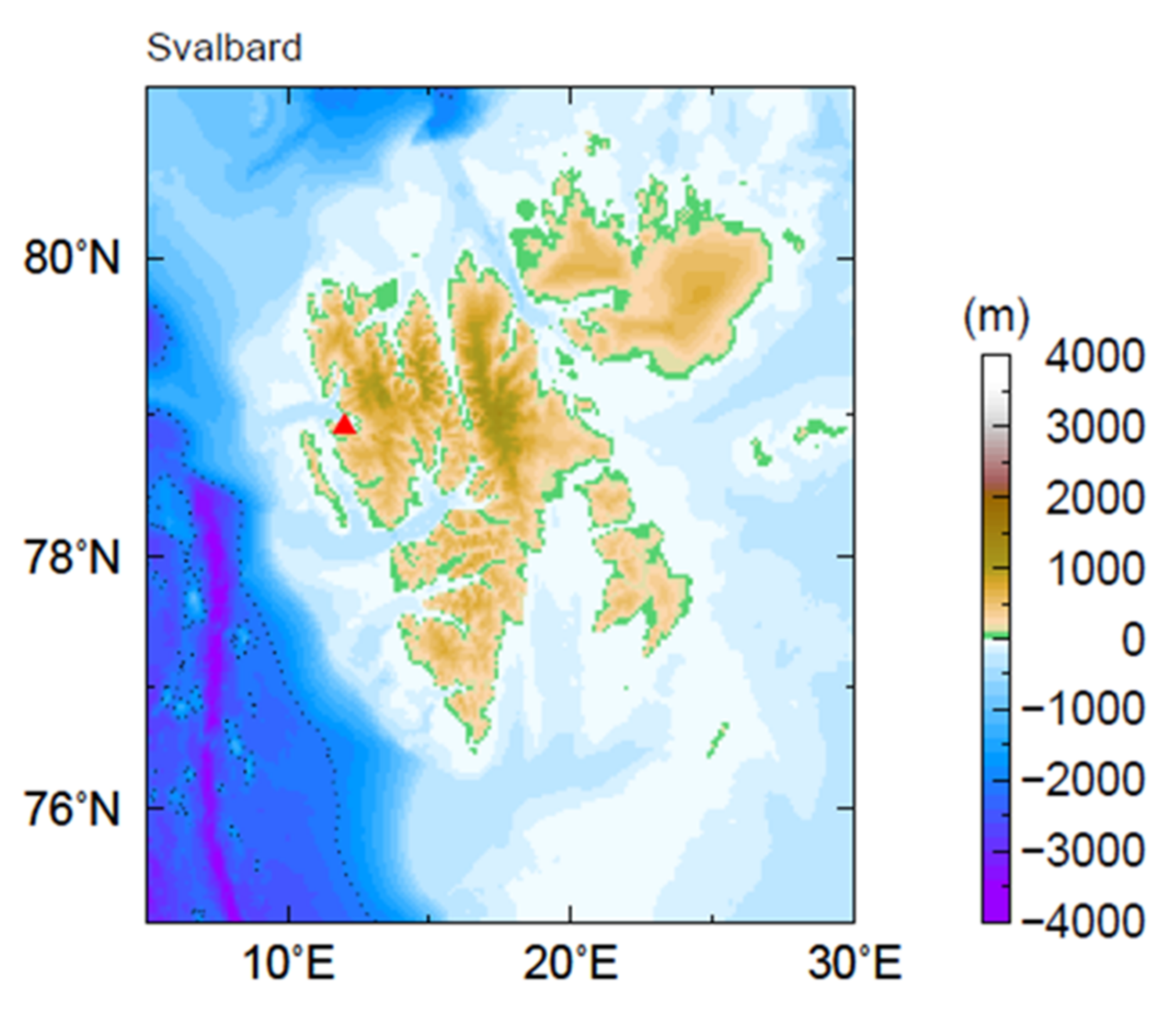
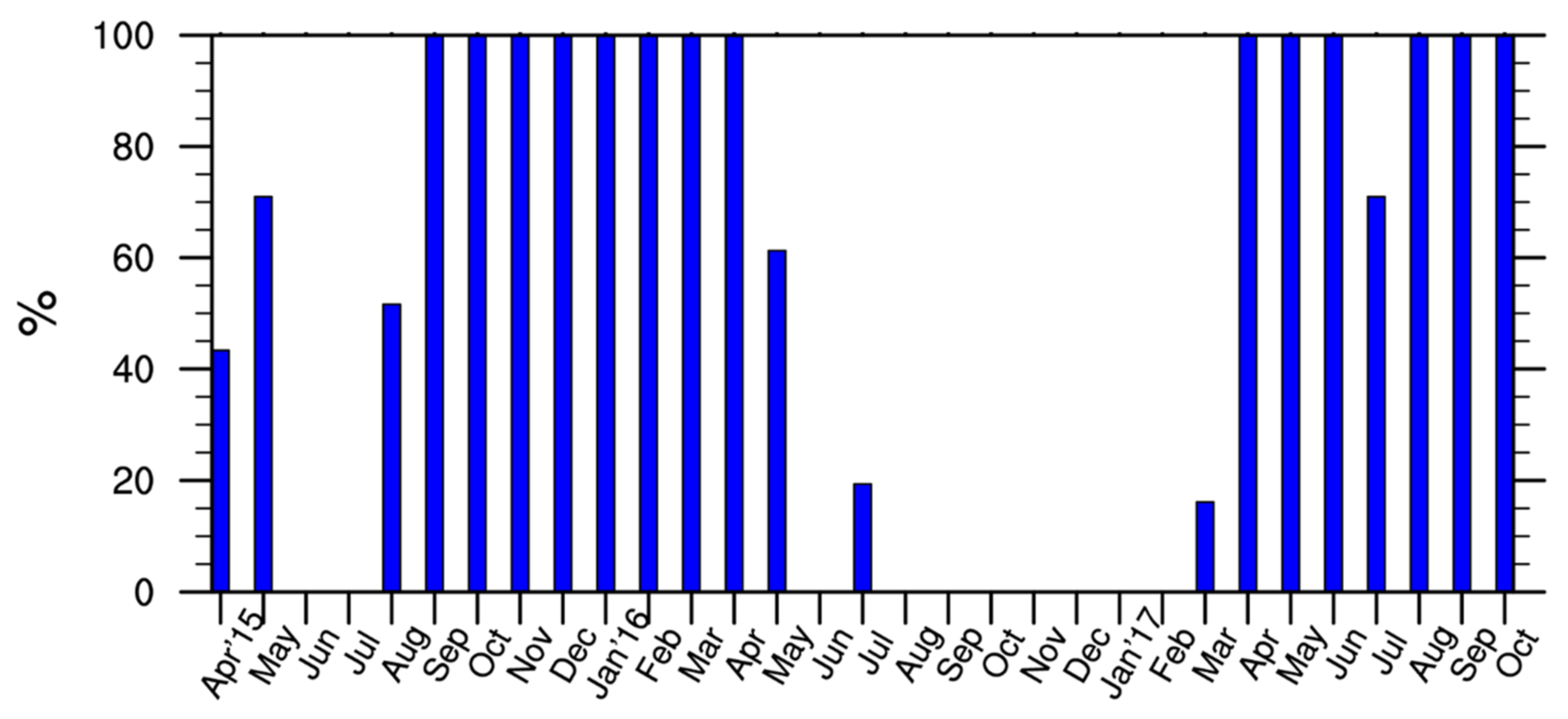

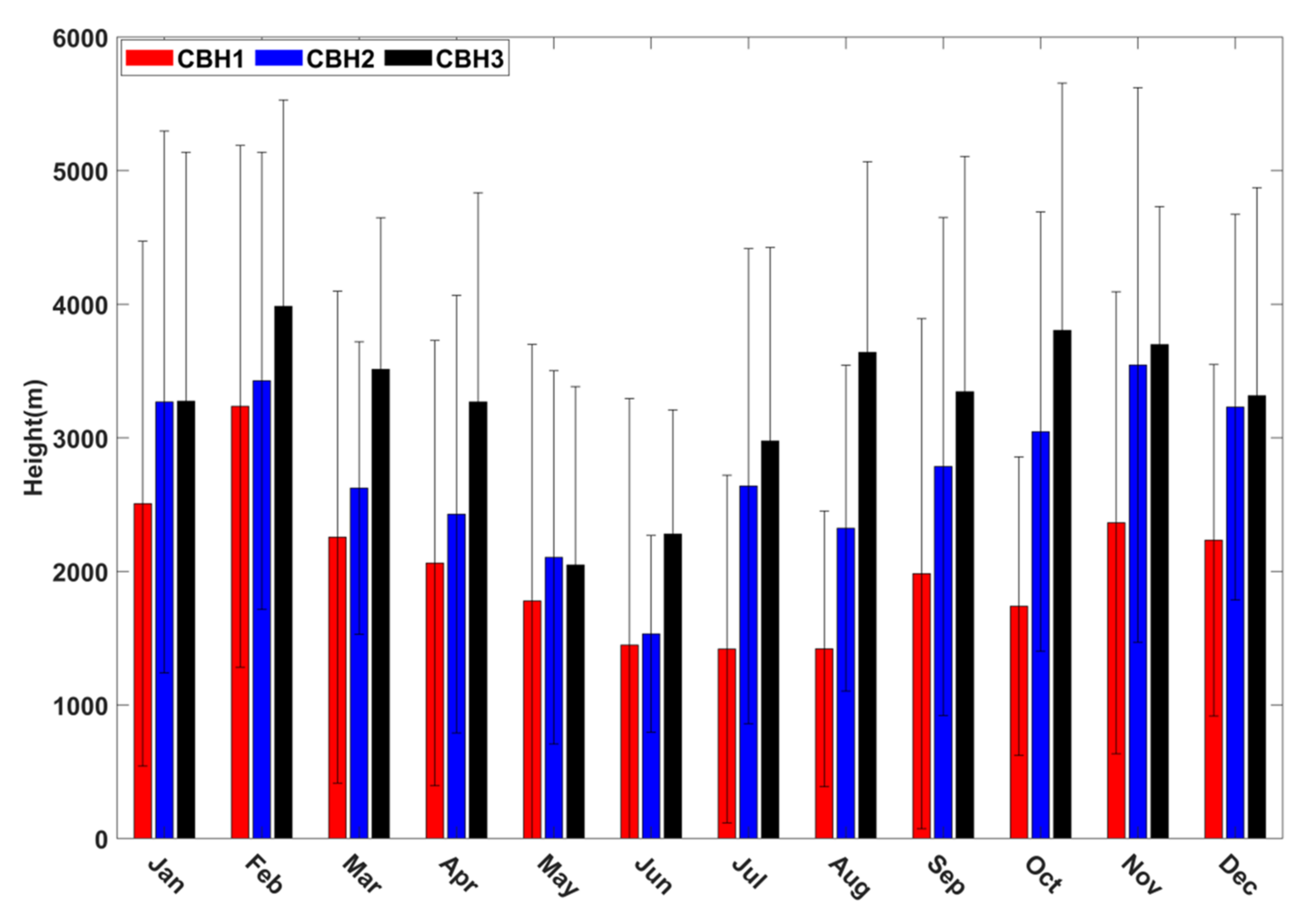


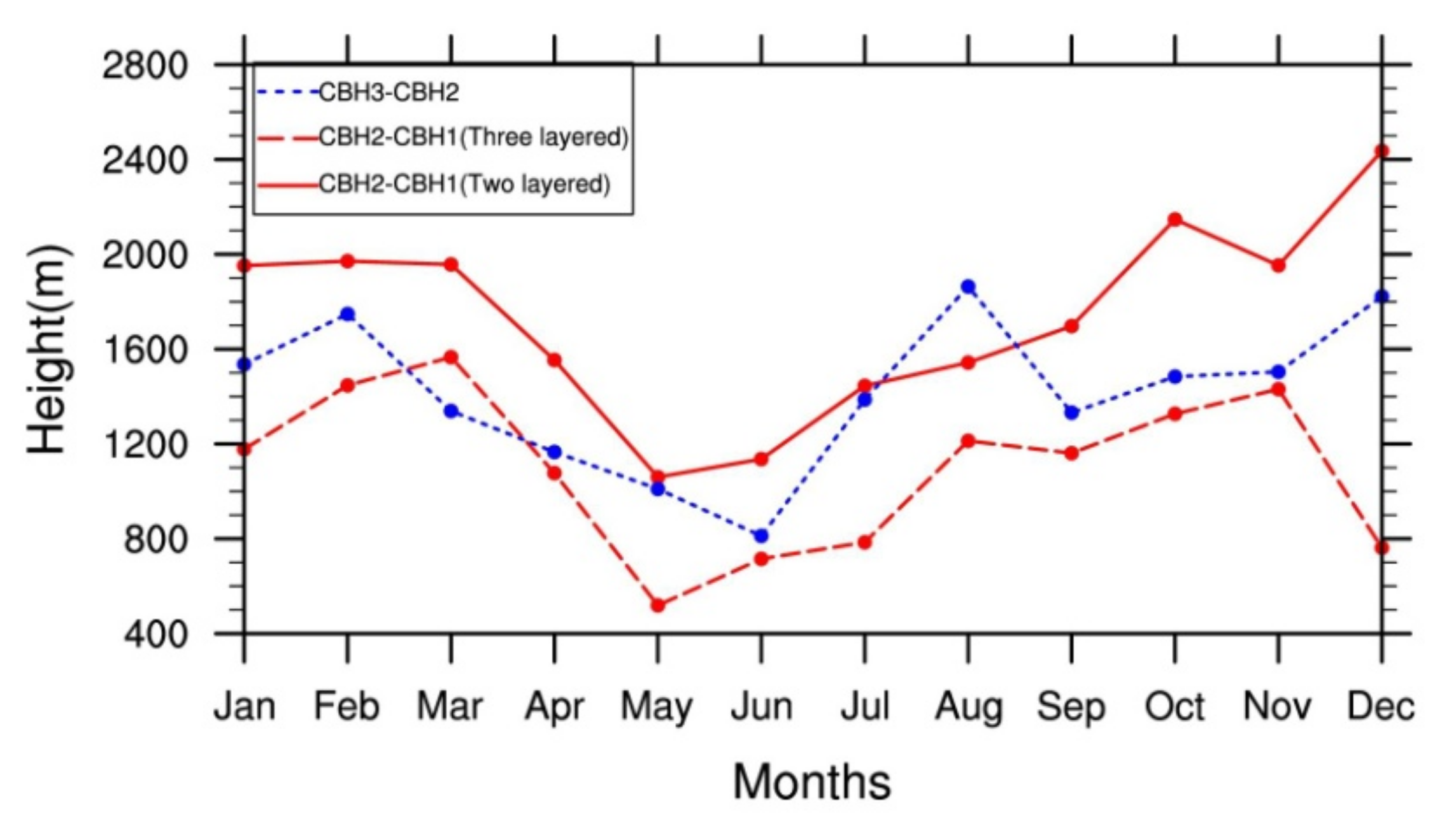
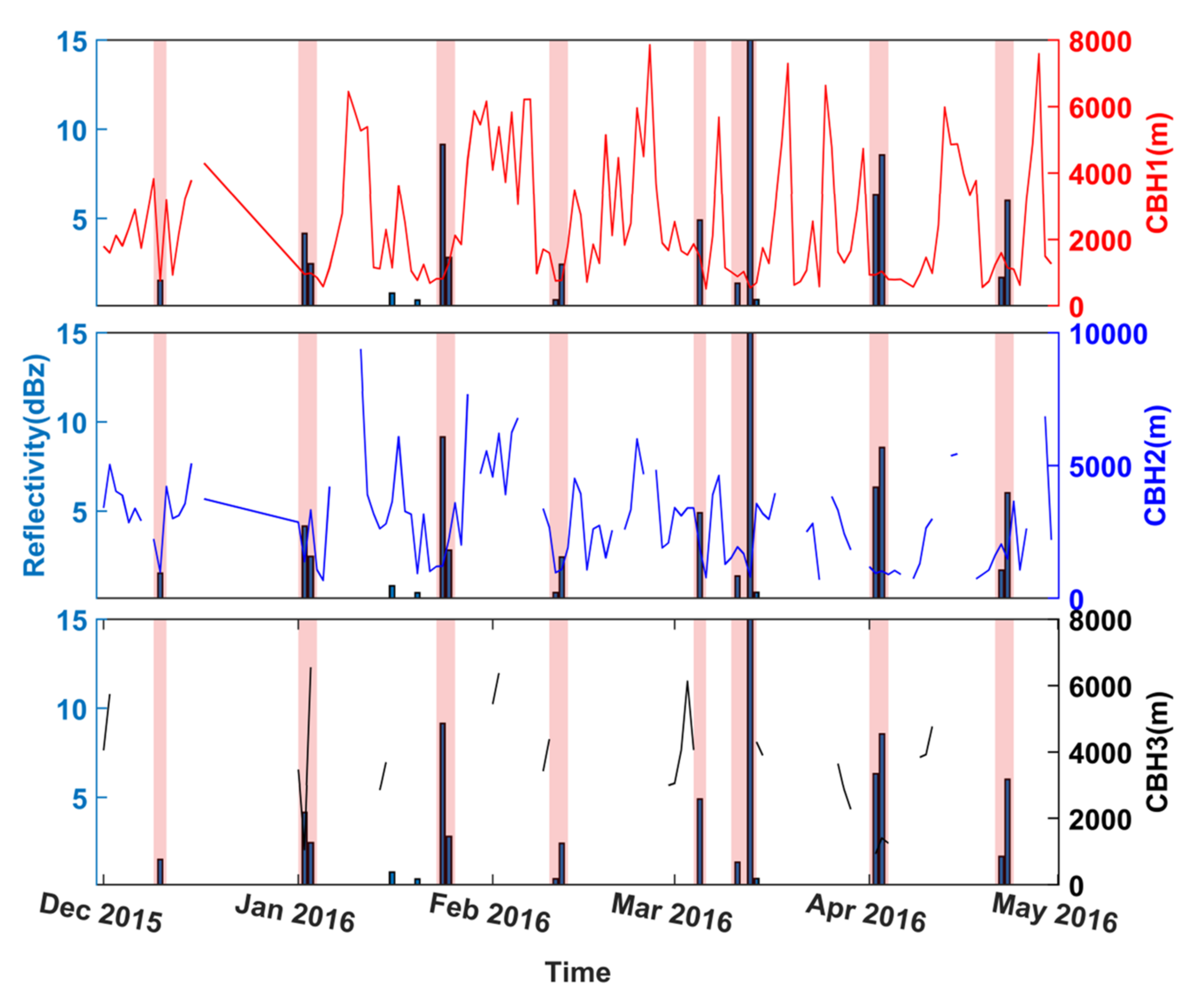
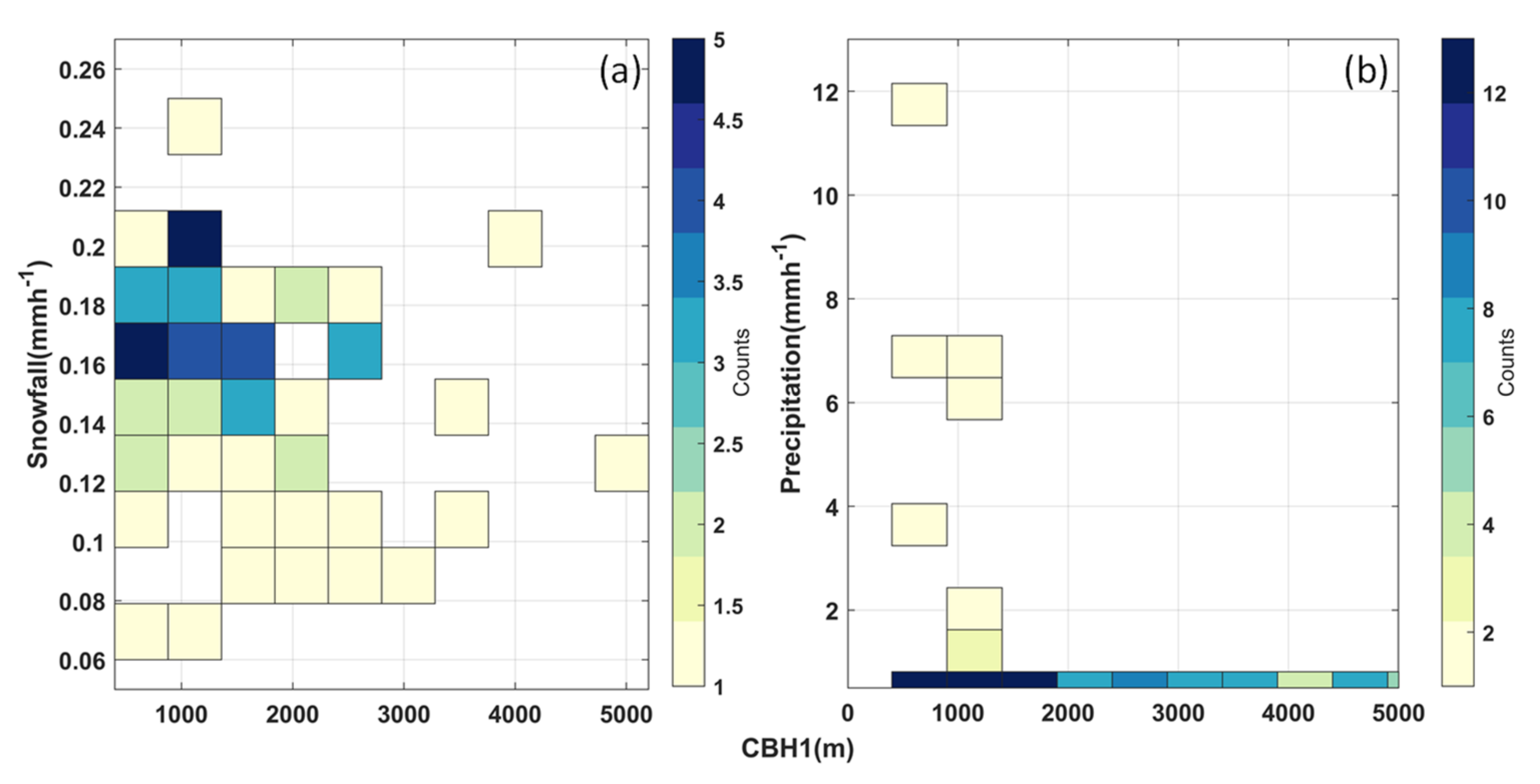




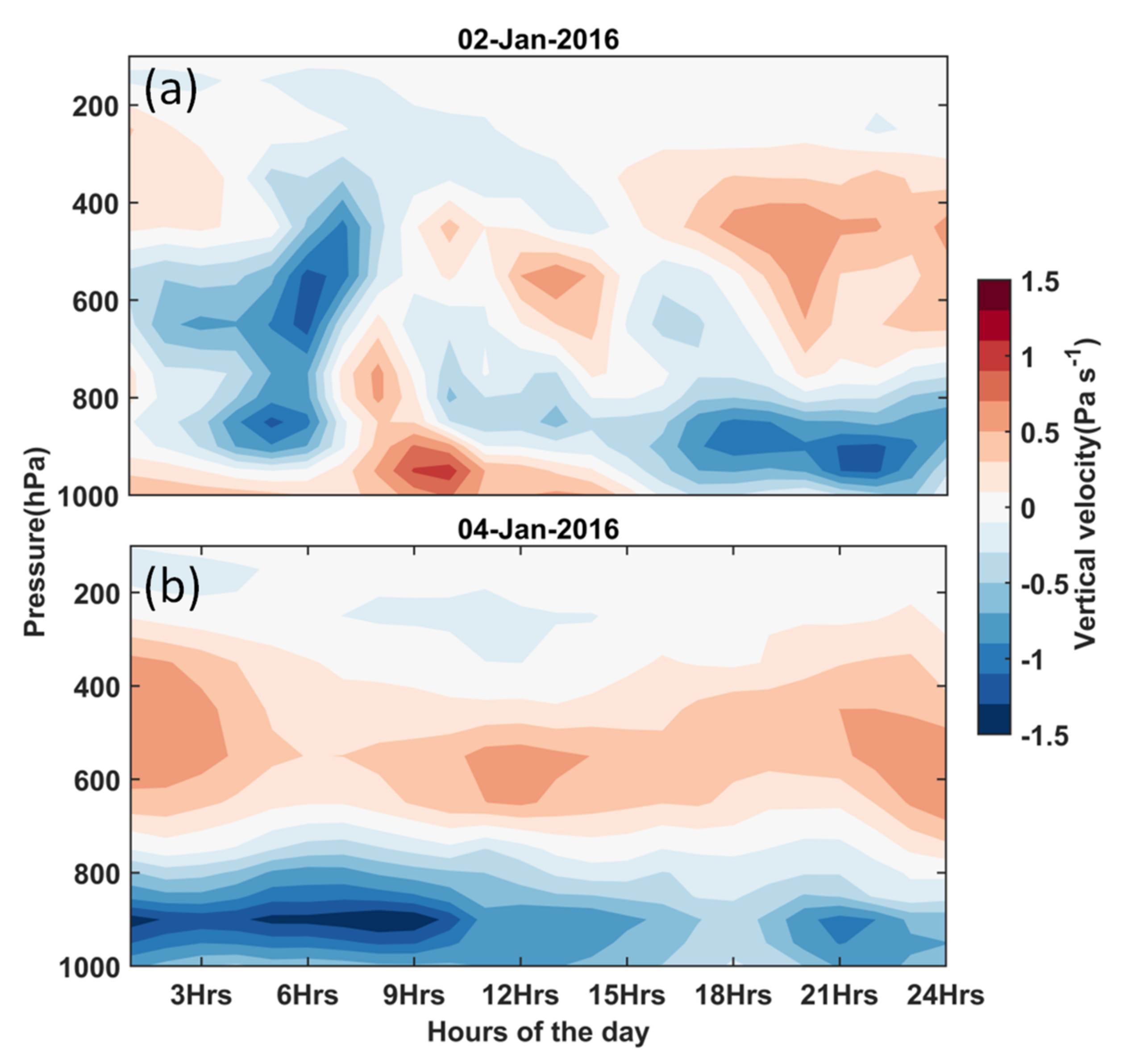
| Properties | Technical Specifications |
|---|---|
| Wavelength (nm) | 910 ± 10 |
| Vertical resolution (m) | 10 m |
| Temporal resolution (s) | 6 s |
| Vertical limit (m) | Up to 3 cloud base heights (CBHs) |
| Transmitter | pulsed |
| Peak power (Watt) | 27 |
| Pulse repetition frequency (kHz) | 6.5 |
| Detection range (km) | ~15 km |
| Properties | Technical Specifications |
|---|---|
| Frequency of operation | K-Band (~24 GHz) |
| Working method | Doppler’s principle |
| Sampling Frequency | 125 kHz |
| Transmitter | Continuous |
| Vertical resolution | >10 m |
| Velocity resolution | 0.188 m/s |
| Nyquist Velocity Range | 0–12.3 m/s |
| Detection range (m) | 50–6000 m |
Publisher’s Note: MDPI stays neutral with regard to jurisdictional claims in published maps and institutional affiliations. |
© 2021 by the authors. Licensee MDPI, Basel, Switzerland. This article is an open access article distributed under the terms and conditions of the Creative Commons Attribution (CC BY) license (https://creativecommons.org/licenses/by/4.0/).
Share and Cite
Asutosh, A.; Chatterjee, S.; Subeesh, M.P.; Radhakrishnan, A.; Murukesh, N. Observation of Cloud Base Height and Precipitation Characteristics at a Polar Site Ny-Ålesund, Svalbard Using Ground-Based Remote Sensing and Model Reanalysis. Remote Sens. 2021, 13, 2808. https://doi.org/10.3390/rs13142808
Asutosh A, Chatterjee S, Subeesh MP, Radhakrishnan A, Murukesh N. Observation of Cloud Base Height and Precipitation Characteristics at a Polar Site Ny-Ålesund, Svalbard Using Ground-Based Remote Sensing and Model Reanalysis. Remote Sensing. 2021; 13(14):2808. https://doi.org/10.3390/rs13142808
Chicago/Turabian StyleAsutosh, Acharya, Sourav Chatterjee, M.P. Subeesh, Athulya Radhakrishnan, and Nuncio Murukesh. 2021. "Observation of Cloud Base Height and Precipitation Characteristics at a Polar Site Ny-Ålesund, Svalbard Using Ground-Based Remote Sensing and Model Reanalysis" Remote Sensing 13, no. 14: 2808. https://doi.org/10.3390/rs13142808
APA StyleAsutosh, A., Chatterjee, S., Subeesh, M. P., Radhakrishnan, A., & Murukesh, N. (2021). Observation of Cloud Base Height and Precipitation Characteristics at a Polar Site Ny-Ålesund, Svalbard Using Ground-Based Remote Sensing and Model Reanalysis. Remote Sensing, 13(14), 2808. https://doi.org/10.3390/rs13142808





